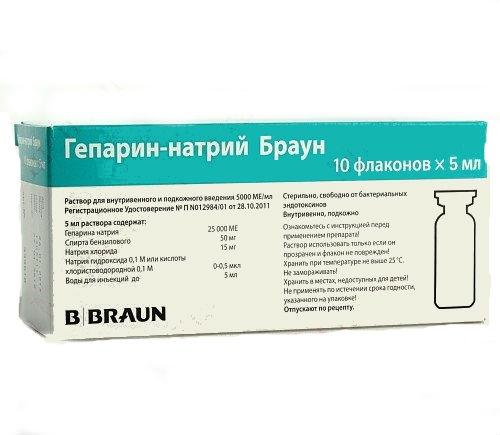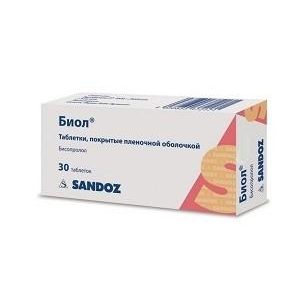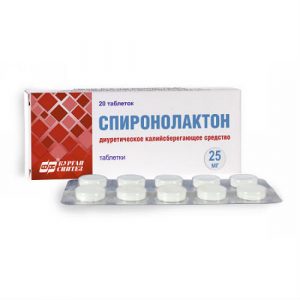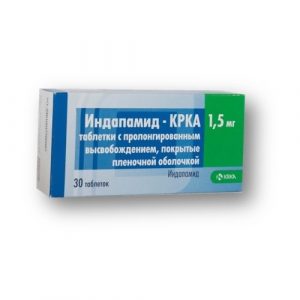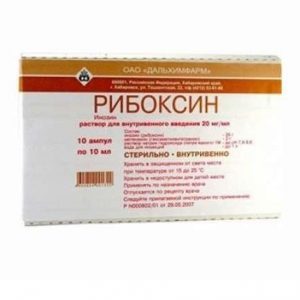Description
Release form
Injection.
Packing
10 fl. 5 ml each.
Pharmacological action
Heparin is a direct-acting anticoagulant. It slows down the formation of fibrin, is a physiological anticoagulant that potentiates the ability of antithrombin III to inhibit activated coagulation factors IXa, Xa, XIa, XIIa, and in high concentrations, thrombin activity.
Particularly important is the ability to inhibit activated factor X, which is involved in the internal and external coagulation system (this action is manifested against the background of much lower doses of heparin than is required to suppress the activity of thrombin, which contributes to the formation of fibrin from fibrinogen, which justifies the possibility of subcutaneous administration of small doses heparin for the prevention of venous thrombosis and large doses – for treatment).
Heparin is not able to dissolve a blood clot (it is not a fibrinolytic), but can reduce the size of a blood clot by stopping its growth, in which case part of the blood clot dissolves under the influence of natural fibrinolytic enzymes.
Inhibits the activity of hyaluronidase. Reduces surfactant activity in the lungs.
Reduces the risk of developing acute coronary artery thrombosis, myocardial infarction and sudden death.
It is effective in high doses for pulmonary embolism and venous thrombosis, in small doses – for the prevention of venous thromboembolism, including after surgery.
Indications
Prevention and treatment: – deep vein thrombosis, pulmonary thromboembolism (including in diseases of peripheral veins), coronary artery thrombosis
– unstable angina pectoris
– acute myocardial infarction
– atrial fibrillation, accompanied by embolization
– DIC (first phase).
Prevention of blood coagulation during operations using extracorporeal blood circulation methods, blood transfusion, hemodialysis, and blood sampling for examination.
Contraindications
– diseases accompanied by impaired blood coagulation
– ulcerative lesions of the gastrointestinal tract (ulcers of the stomach, duodenum and ileum, ulcerative colitis, malignant neoplasms)
– subacute bacterial endocarditis
– severe impaired liver function
– severe impaired renal function
– hemorrhagic stroke
– severe arterial hypertension
– recent surgery on the gland, brain, ways, a condition after a spinal cord puncture
– hypersensitivity to the drug.
Caution is required in patients with polyvalent allergies (heparin is an extract from animal tissue).
Special instructions
Heparin cannot be administered intramuscularly, as hematomas may form at the injection site.
A heparin solution may become yellow in color, which does not alter its activity or tolerance.
When prescribing heparin for therapeutic purposes, its dose is selected depending on the value of APTT. During the use of heparin, other drugs should not be administered intramuscularly and an organ biopsy should be performed.
Only saline is used to dilute heparin.
Composition
1 ml of the solution contains sodium heparin 5000 IU.
Dosage and administration of
For therapeutic purposes, Heparin is prescribed as an intravenous drip infusion at a dose of 15 IU / kg / h (i.e. for adults with an average body weight of 1 thousand IU / h).
Immediately before the infusion, in order to achieve a quick anticoagulant effect, the drug is injected iv in a dose of 5 thousand IU (1 ml).
If iv cannot be administered for any reason, the drug is administered s / c – 10 thousand IU (2 ml) 4 times a day. The daily dose should not exceed 60-80 thousand IU.
The use of the drug in a maximum daily dose of more than 10 days is possible only in exceptional cases.
For prophylactic purposes to prevent thrombosis, heparin is administered under the skin of the abdomen 5 thousand IU (1 ml) 2 times a day.
Side effects
Allergic reactions: rhinitis, urticaria, lacrimation, fever, bronchospasm.
Other: when using the drug in high doses and / or with prolonged treatment, bleeding from mucous membranes and wounds, the development of thrombocytopenia are possible.
Drug interaction
The effect of heparin is enhanced by: antibiotics (reduce the formation of vitamin K by the intestinal microflora), acetylsalicylic acid, dipyridamole, non-steroidal anti-inflammatory drugs and other drugs that reduce platelet aggregation (which remain the main mechanism of hepatic disease in patients with hepatic disease).
Reduce the effects of heparin: antihistamines, phenothiazines, cardiac glycosides, nicotinic acid, tetracyclines, ergot alkaloids, nicotine, nitroglycerin (iv), thyroxine, ACTH, alkaline amines and polypeptides, protamine.
Heparin should not be mixed in the same syringe with other drugs.
Overdose
Symptoms: bleeding of varying severity.
Treatment: With a small bleeding, the dose should be reduced or the drug should be temporarily stopped.
With extensive bleeding, excess heparin is neutralized with protamine sulfate (1 mg protamine sulfate per 100 ME of heparin).
It should be borne in mind that heparin is rapidly eliminated and if protamine sulfate is given 30 min after the previous dose of heparin, only half of the required dose should be administered, the maximum dose of protamine sulfate is 50 mg.
Storage Conditions
In a dry, cool, dark place, out of the reach of children.
Active ingredient
Heparin sodium
Terms leave through pharmacies
In retseptu
lekarstvennaja form
Solution for
Indications
prevention of acute myocardial infarction, prophylaxis of thromboembolism, Angina pectoris, Prevention of thrombosis
Possible product names
HEPARIN-SODIUM BROWN 5000ME / ML 5ML N10 FLAK RR R
HEPARIN-SODIUM VRED VRYU BRAU 5000 IU / ML (BOTTLES) 5 ML No. 10
Heparin-sodium Brown solution for I / O and p / skin inject. 5000 IU / ml 5 ml bottle 10 pcs.
B.Groun19Group19Group19Group19Group19Group19Groun19 .Brown Melzungen AG, Germany
